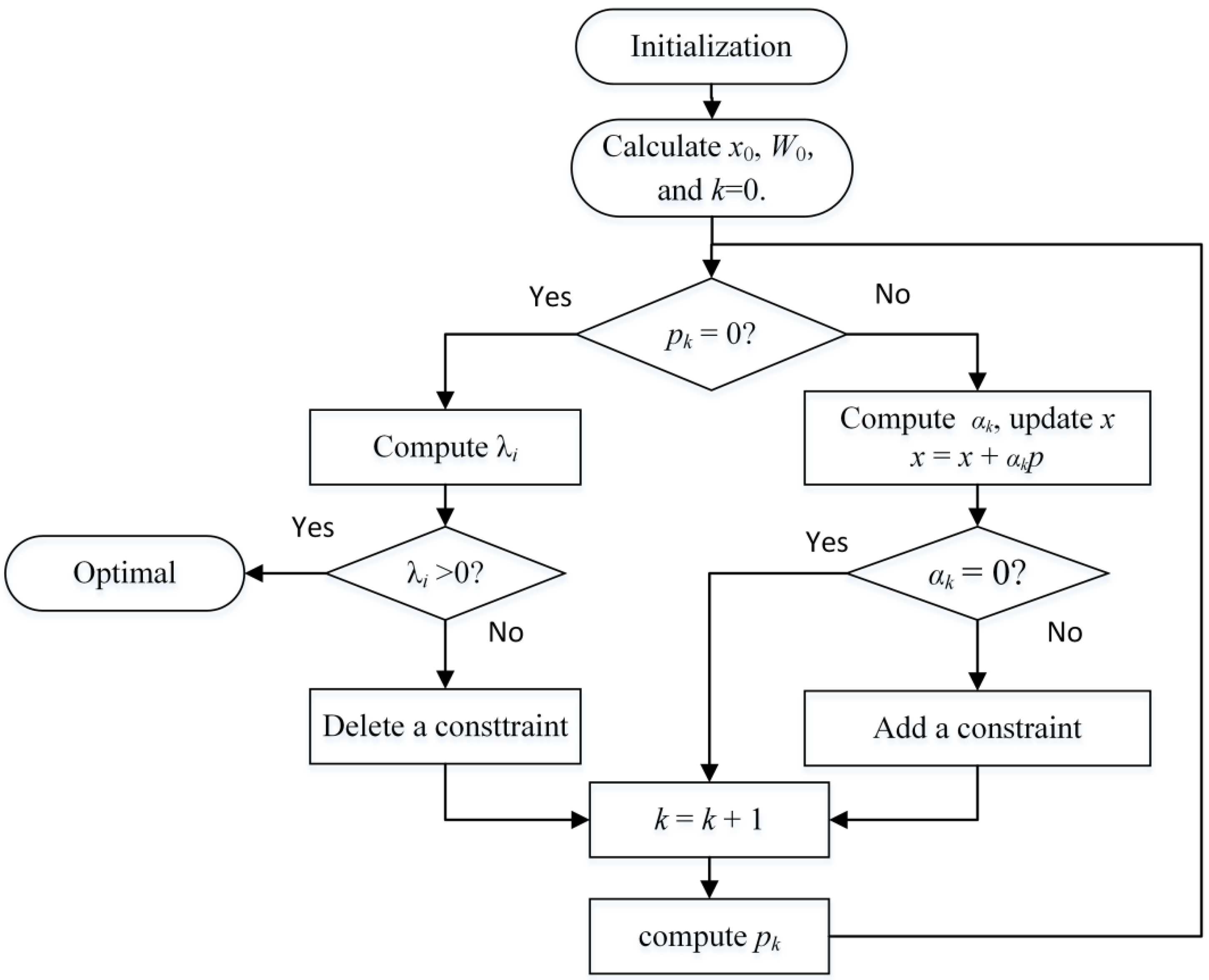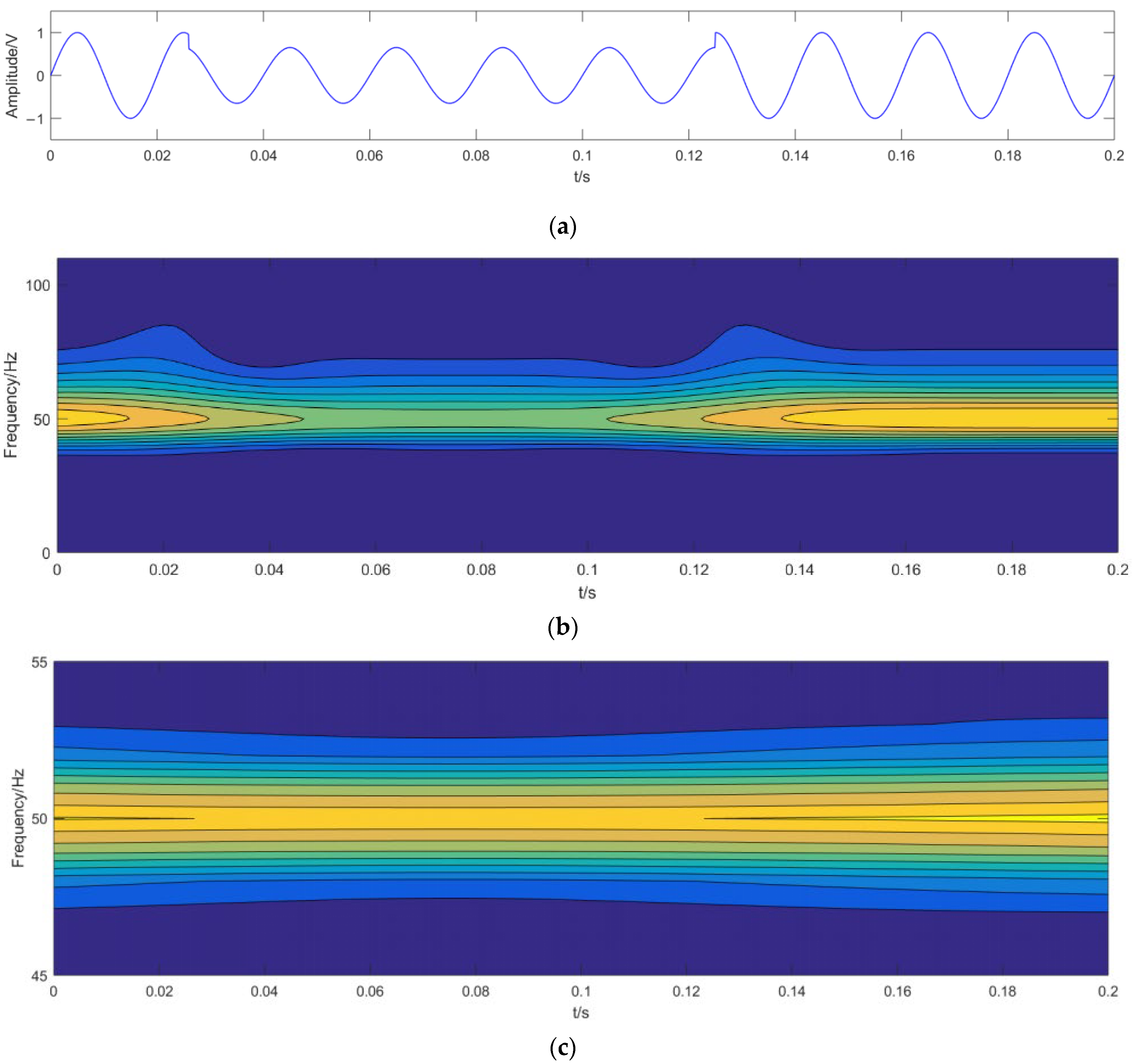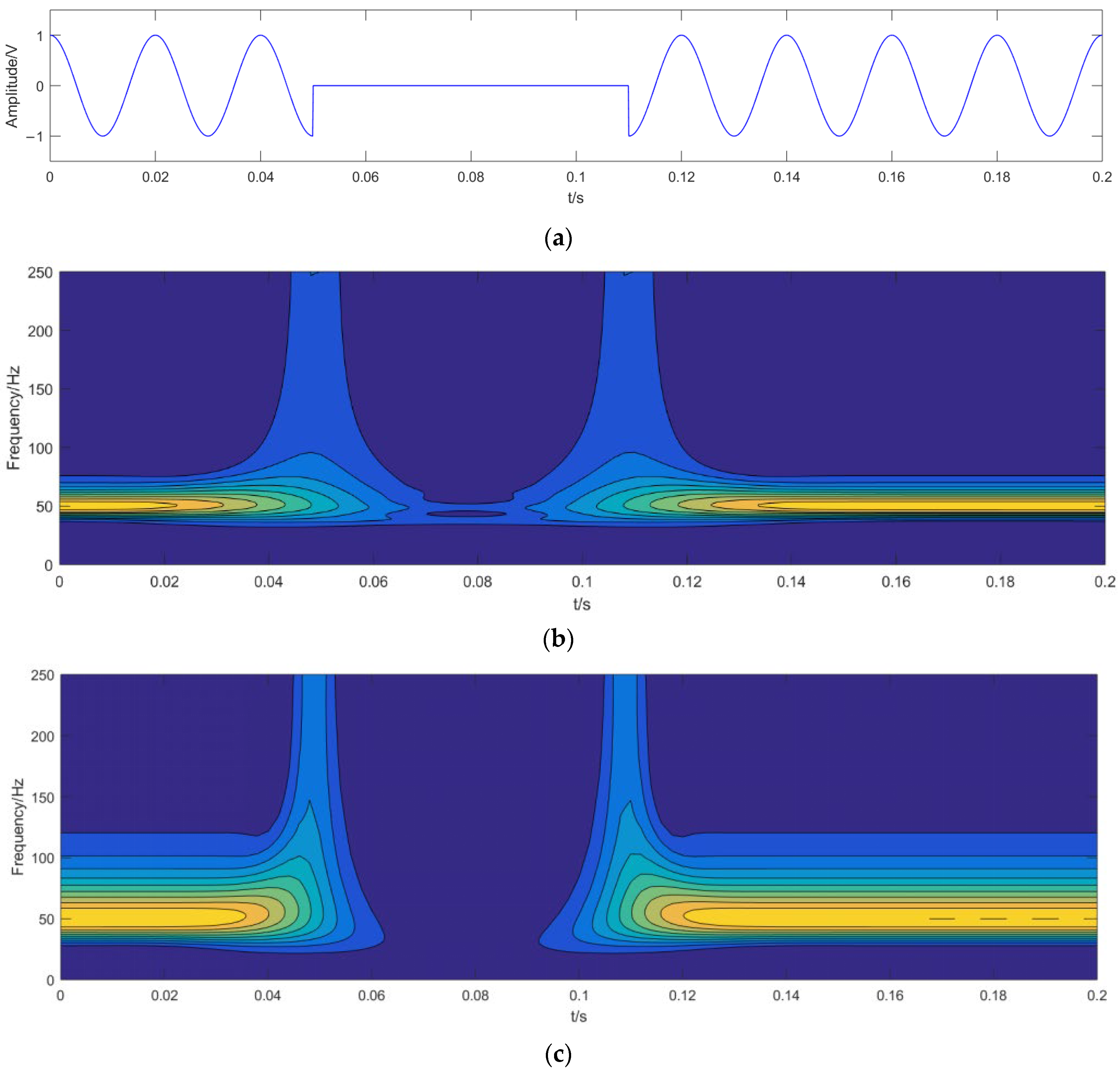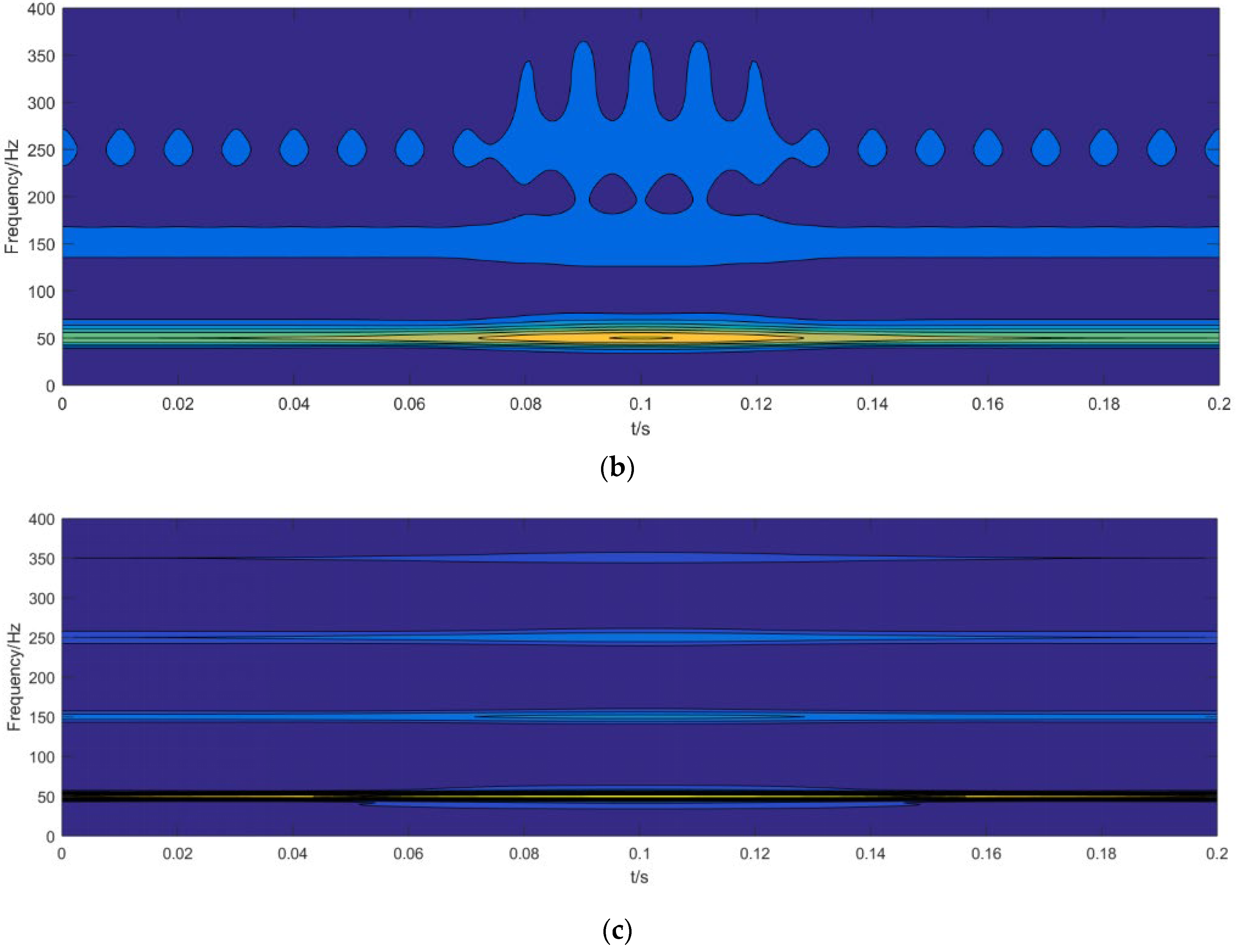Power Quality Disturbances Recognition Using Modified S-Transform Based on Optimally Concentrated Window with Integration of Renewable Energy
Abstract
:1. Introduction
2. Standard S-Transform
3. S-Transform Based on Optimally Concentrated Window
3.1. Modified S-Transform
3.2. Adaptation of the Generalised Window Parameters
3.3. Algorithm
- Calculate the feasible initial point , and the efficient constraint set at is . ;
- Solve the subproblem, and get ;
- If , calculate the corresponding value of that meets the requirements, and ;If , the calculation is stopped, and . Otherwise, select to make meet the requirements. Let , , then turn to step 5;
- If , calculate the value of ; if , calculate the values of to make meet the requirements, and let . Then turn to step 5;
- , and turn to step 2.
4. Simulation Results and Discussion
4.1. Voltage Sag and Voltage Swell
4.2. Transient Oscillation
4.3. Voltage Interruption
4.4. Voltage Sag and Voltage Swell with Harmonics
5. Conclusions
Author Contributions
Funding
Institutional Review Board Statement
Informed Consent Statement
Data Availability Statement
Conflicts of Interest
References
- Bullich-Massagué, E.; Ferrer-San-José, R.; Aragüés-Peñalba, M.; Serrano-Salamanca, L.; Pacheco-Navas, C.; Gomis-Bellmunt, O. Power plant control in large-scale photovoltaic plants: Design, implementation and validation in a 9.4 MW photovoltaic plant. IET Renew. Power Gener. 2016, 10, 50–62. [Google Scholar] [CrossRef] [Green Version]
- Muhammad, I.H.; Awang, J.; Makbul, A. Photovoltaic plant with reduced output current harmonics using generationside active power conditioner. IET Renew. Power Gener. 2014, 8, 817–826. [Google Scholar]
- Xie, N.; Luo, A.; Chen, Y.; Ma, F.; Xu, X.; Lu, Z.; Shuai, Z. Dynamic modeling and characteristic analysis on harmonics of photovoltaic power stations. Proc. CSEE 2013, 33, 10–17. [Google Scholar]
- Hu, H.; Shi, Q.; He, Z.; He, J.; Gao, S. Potential harmonic resonance impacts of PV inverter filters on distribution systems. IEEE Trans. Sustain. Energy 2015, 6, 151–161. [Google Scholar] [CrossRef]
- Xia, X.; Han, X. A novel active power filter for harmonic suppression and reactive power compensation. In Proceedings of the 2006 1ST IEEE Conference on Industrial Electronics and Applications, Singapore, 24–26 May 2006. [Google Scholar]
- Deokar, S.A.; Waghmare, L.M. Integrated DWT-FFT approach for detection and classification of power quality disturbances. Int. J. Electr. Power Energy Syst. 2014, 61, 594–605. [Google Scholar] [CrossRef]
- Jaramillo, S.H.; Heydt, G.T.; O’Neill-Carrillo, E. Power quality indices for aperiodic voltages and currents. IEEE Trans. Power Deliv. 2000, 15, 784–790. [Google Scholar] [CrossRef]
- Erişti, H.; Demir, Y. Automatic classification of power quality events and disturbances using wavelet transform and support vector machines. IET Gener. Transm. Distrib. 2012, 6, 968–976. [Google Scholar] [CrossRef]
- De Yong, D.; Magnago, F.; Magnago, F. An effective power quality classifier using wavelet transform and support vector machines. Expert Syst. Appl. 2015, 42, 6075–6081. [Google Scholar] [CrossRef]
- Afroni, M.J.; Sutanto, D.; Stirling, D. Analysis of nonstationary power-quality waveforms using iterative Hilbert Huang transform and SAX algorithm. IEEE Trans. Power Deliv. 2013, 28, 2134–2144. [Google Scholar] [CrossRef]
- Biswal, B.; Biswal, M.; Mishra, S.; Jalaja, R. Automatic classification of power quality events using balanced neural tree. IEEE Trans. Ind. Electron. 2014, 61, 521–530. [Google Scholar] [CrossRef]
- Griffin, D.; Lim, J. Signal estimation from modified short-time Fourier transform. IEEE Trans. Acoust. Speech Signal Process. 1984, 32, 236–243. [Google Scholar] [CrossRef]
- Stockwell, R.G.; Mansinha, L.; Lowe, R.P. Localization of the complex spectrum: The S-transform. IEEE Trans. Signal Process. 1996, 44, 998–1001. [Google Scholar] [CrossRef]
- Huang, N.; Xu, D.; Liu, X.; Lin, L. Power quality disturbances classification based on S-transform and probabilistic neural network. Neurocomputing 2012, 98, 12–23. [Google Scholar] [CrossRef]
- Jianmin, L.; Zhaosheng, T.; Qiu, T.; Junhao, S. Detection and classification of power quality disturbances using double resolution S-transform and DAG-SVMs. IEEE Trans. Instrum. Meas. 2016, 65, 2302–2312. [Google Scholar]
- Chakraborty, A.; Okaya, D. Frequency-time decomposition of seismic data using wavelet-based methods. Geophisics 1995, 60, 1906–1916. [Google Scholar] [CrossRef] [Green Version]
- Sahani, M.; Dash, P.K. Automatic Power Quality Events Recognition based on Hilbert Huang Transform and Extreme Learning Machine. IEEE Trans. Ind. Inform. 2018, 14, 3849–3858. [Google Scholar] [CrossRef]
- Boashash, B. Time frequency signal analysis: Past, present and future trends. Control Dyn. Syst. 1996, 78, 1–69. [Google Scholar]
- Cohen, L. Time frequency distribution-a review. Proc. IEEE 1989, 77, 941–981. [Google Scholar] [CrossRef] [Green Version]
- Orallo, C.M.; Carugati, I.; Maestri, S.; Donato, P. Harmonics measurement with a modulated sliding discrete Fourier transform algorithm. IEEE Trans. Instrum. Meas. 2014, 63, 781–793. [Google Scholar] [CrossRef]
- Kwok, H.K.; Jones, D.L. Improved instantaneous frequency estimation using an adaptive short-time Fourier transform. IEEE Trans. Signal Process. 2015, 48, 2964–2972. [Google Scholar] [CrossRef]
- Zhao, X.; Ye, B. Convolution wavelet packet transform and its applications to signal processing. Digit. Signal Process. N. Y. 2010, 20, 1352–1364. [Google Scholar] [CrossRef]
- Duan, Z.; Zhang, J.; Zhang, C.; Mosca, E. A simple design method of reduced-order filters and its applications to multirate filter bank design. Signal Process. 2006, 86, 1061–1075. [Google Scholar] [CrossRef]
- Ma, J.; Jiang, J. Analysis and design of modified window shapes for S-transform to improve time-frequency localization. Mech. Syst. Signal Process. 2015, 58, 271–284. [Google Scholar] [CrossRef]
- Li, J.; Yang, Y.; Lin, H.; Teng, Z.; Zhang, F.; Xu, Y. A voltage sag detection method based on modified S transform with digital prolate spheroidal window. IEEE Trans. Power Deliv. 2021, 36, 997–1006. [Google Scholar] [CrossRef]
- Mahela, O.P.; Shaik, A.G.; Khan, B.; Mahla, R.; Alhelou, H.H. Recognition of complex power quality disturbances using S-transform based ruled decision tree. IEEE Access 2020, 8, 173530–173547. [Google Scholar] [CrossRef]
- Djurovi, I.; Sejdi, E.; Jiang, J. Frequency-based window width optimization for S-transform. AEU-Int. J. Electron. Commun. 2008, 62, 245–250. [Google Scholar] [CrossRef]
- Zhang, S.; Li, P.; Zhang, L.; Li, H.; Jiang, W.; Hu, Y. Modified S transform and ELM algorithms and their applications in power quality analysis. Neurocomputing 2016, 185, 231–241. [Google Scholar] [CrossRef]
- Sejdi´c, E.; Djurovi´c, I.; Jiang, J. A window width optimized S transform. EURASIP J. Adv. Signal Process. 2008, 2008, 672941. [Google Scholar] [CrossRef] [Green Version]
- Yao, W.; Teng, Z.; Tang, Q.; Zuo, P. Adaptive Dolph-Chebyshev window-based S transform in time-frequency analysis. IET Signal Process 2014, 8, 927–937. [Google Scholar] [CrossRef]
- Pinnegar, C.R.; Mansinha, L. The bi-Gaussian S-transform. SIAM J. Sci. Comput. 2003, 24, 1678–1692. [Google Scholar]
- Simon, C.; Ventosa, S.; Schimmel, M.; Heldring, A.; Dañobeitia, J.J.; Gallart, J.; Manuel, A. The S-transform and its inverses: Side effects of discretizing and filtering. IEEE Trans. Signal Process 2007, 55, 49284937. [Google Scholar] [CrossRef] [Green Version]
- Qiu, W.; Tang, Q.; Liu, J.; Teng, Z.; Yao, W. Power Quality Disturbances Recognition Using Modified S Transform and Parallel Stack Sparse Auto-encoder. Electr. Power Syst. Res. 2019, 174, 105876. [Google Scholar] [CrossRef]
- Wang, Q.; Gao, J.; Liu, N.; Jiang, X. High-resolution seismic time-frequency analysis using the synchrosqueezing generalized S-Transform. IEEE Geosci. Remote Sens. Lett. 2018, 15, 374–378. [Google Scholar] [CrossRef]
- Brown, R.A.; Lauzon, M.L.; Frayne, R.F. A general description of linear time-frequency transforms and formulation of a fast, invertible transform that samples the continuous S-Transform spectrum nonredundantly. IEEE Trans. Signal Process. 2010, 58, 281–290. [Google Scholar] [CrossRef]
- Ali, M.; Zied, B.; Djaffar, O.A.; Alain, D. A new optimized Stockwell transform applied on synthetic and real non-stationary signals. Digit. Signal Process. 2015, 46, 226–238. [Google Scholar]






Publisher’s Note: MDPI stays neutral with regard to jurisdictional claims in published maps and institutional affiliations. |
© 2021 by the authors. Licensee MDPI, Basel, Switzerland. This article is an open access article distributed under the terms and conditions of the Creative Commons Attribution (CC BY) license (https://creativecommons.org/licenses/by/4.0/).
Share and Cite
Su, D.; Li, K.; Shi, N. Power Quality Disturbances Recognition Using Modified S-Transform Based on Optimally Concentrated Window with Integration of Renewable Energy. Sustainability 2021, 13, 9868. https://0-doi-org.brum.beds.ac.uk/10.3390/su13179868
Su D, Li K, Shi N. Power Quality Disturbances Recognition Using Modified S-Transform Based on Optimally Concentrated Window with Integration of Renewable Energy. Sustainability. 2021; 13(17):9868. https://0-doi-org.brum.beds.ac.uk/10.3390/su13179868
Chicago/Turabian StyleSu, Dan, Kaicheng Li, and Nian Shi. 2021. "Power Quality Disturbances Recognition Using Modified S-Transform Based on Optimally Concentrated Window with Integration of Renewable Energy" Sustainability 13, no. 17: 9868. https://0-doi-org.brum.beds.ac.uk/10.3390/su13179868




